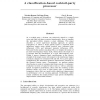Free Online Productivity Tools
i2Speak
i2Symbol
i2OCR
iTex2Img
iWeb2Print
iWeb2Shot
i2Type
iPdf2Split
iPdf2Merge
i2Bopomofo
i2Arabic
i2Style
i2Image
i2PDF
iLatex2Rtf
Sci2ools
NIPS
2003
2003
A Classification-based Cocktail-party Processor
At a cocktail party, a listener can selectively attend to a single voice and filter out other acoustical interferences. How to simulate this perceptual ability remains a great challenge. This paper describes a novel supervised learning approach to speech segregation, in which a target speech signal is separated from interfering sounds using spatial location cues: interaural time differences (ITD) and interaural intensity differences (IID). Motivated by the auditory masking effect, we employ the notion of an ideal time-frequency binary mask, which selects the target if it is stronger than the interference in a local time-frequency unit. Within a narrow frequency band, modifications to the relative strength of the target source with respect to the interference trigger systematic changes for estimated ITD and IID. For a given spatial configuration, this interaction produces characteristic clustering in the binaural feature space. Consequently, we perform pattern classification in order t...
| Added | 31 Oct 2010 |
| Updated | 31 Oct 2010 |
| Type | Conference |
| Year | 2003 |
| Where | NIPS |
| Authors | Nicoleta Roman, DeLiang L. Wang, Guy J. Brown |
Comments (0)

